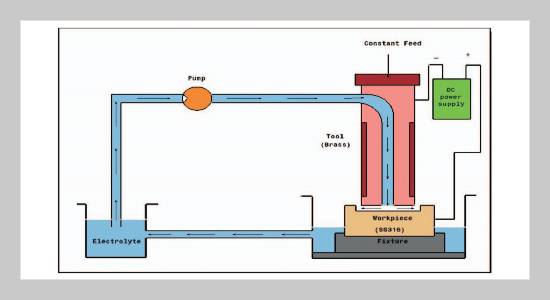REFERENCES
- [1] Bhattacharyya, B., Doloi, B. and Sridhar, P. S., “Electrochemical Micro-Machining: New Possibilities for Micro-manufacturing,” J. Material Processing Technology, Vol. 113, No. 1, pp. 301305 (2001).
- [2] Kozak, J., Rajurkar, K. P. and Makkar, Y., “Selected Problems of Micro Electrochemical Machining,” Journal of Materials Processing Technology, Vol. 149, No. 1, pp. 426431(2004). doi: 10.1016/j.jmatprotec.2004. 02.031
- [3] Rao, S. and Padmanabhan, G., “Effect of Process Variables on Metal Removal Rate in Electrochemical Machining of Al-B4C Composites,” Archives of Applied Science Research, Vol. 4, No.4, pp. 18441849 (2012).
- [4] Mukherjee, S. K., Kumar, S., Srivastava, P. K. and Kumar, A., “Effect of Valency on Metal Removal Rate in Electrochemical Machining of Aluminium,” J. Material Processing Technology, Vol. 202, pp. 398401 (2008). doi: 10.1016/j.jmatprotec.2007.09.065
- [5] Datta, M., “Anodic Dissolution of Metals at High Rates,” IBM Journal of Research and Development, Vol. 37, No. 2, pp. 207226 (1993). doi: 10.1147/rd. 372.0207
- [6] Neto, J. C. D. S., Silva, E. M. D. and Silva, M. B. D., “Intervening Variables in Electrochemical Machining,” Journal of Material Processing Technology, Vol. 179, pp. 9296 (2006). doi: 10.1016/j.jmatprotec.2006.03. 105
- [7] Landolt, D., Muller, R. H. and Tobias, C. W., “High Rate Anodic Dissolution of Copper,” J. Electro Chemi. Soc, Vol. 116, p. 1384 (1969). doi: 10.1149/1.2407947
- [8] Wang, C. B. and Zhang,W. X., “Nanoscale Metal Particles for Dechlorination of TCE and PCBs,” Environ. Sci, Technol, Vol. 31, pp. 21542156 (1997). doi: 10. 1021/es970039c
- [9] Fendorf, S. and Li, G., “Kinetics of Chromate Reduction by Ferrous Iron,” Environmental Science & Technology, Vol. 30, No. 5 pp. 16141617 (1996). doi: 10. 1021/es950618m
- [10] Shupack, S. I., “The Chemistry of Chromium and Some Resulting Analytical Problems,” Environmental Health Perspectives, Vol. 92, pp. 711 (1991). doi: 10.1289/ ehp.91927
- [11] Mount, A. R., Howarth, P. S. and Clifton, D., “The Electrochemical Machining Characteristics of Stainless Steels,” J. Electrochem. Soc, Vol. 150, No. 3, D63 D69 (2003). doi: 10.1149/1.1545463
- [12] Singh, R., Misra, V. and Singh, R. P., “Synthesis Characterization and Role of Zero-valent Iron Nanoparticle in Removal of Hexavalent Chromium from Chromium-spiked Soi,” J. Nanopart, Vol. 13, pp. 4063 4073 (1992). doi: 10.1007/s11051-011-0350-y
- [13] Yang, J. E., Kim, J. S., Ok, Y. S., Kim, S. J. and Yoo, K. Y., “Capacity of Cr(VI) Reduction in an Aqueous Solution Using Different Sources of Zero Valent Irons,” Korean J. Chem. Eng, Vol. 23, pp. 935939 (2006). doi: 10.1007/s11814-006-0011-5
- [14] Chen, S., Yue, Q., Gao, B., Li, Q., Xu, X. and Fu, K., “Adsorption of Hexavalent Chromium from Aqueous Solution by Modified Corn Stalk: A Fixed Bed Column Study,” Bioresource Technology, Vol. 113, pp. 114120 (2011). Retrieved from www.elsevier.com/locate/bio tech; doi: 10.1016/j.bior tech.2011.11.110
- [15] Fendorf, S. E. and Zasoski, R. J., “Chromium (III) Oxidation by �-MnO2. 1. Characterisation,” Environmental Science & Technology, Vol. 26, pp. 7985 (1992). doi: 10.1021/es00025a006
- [16] Sun, Y. P., Li, X. Q., Cao, J., Zhang, W. X. and Wang, H. P., “Characterization of Zero-valent Iron Nanoparticles,” Adv. Colloid Interface, Vol. 120, pp. 4756 (2006). doi: 10.1016/j.cis.2006.03.001
















